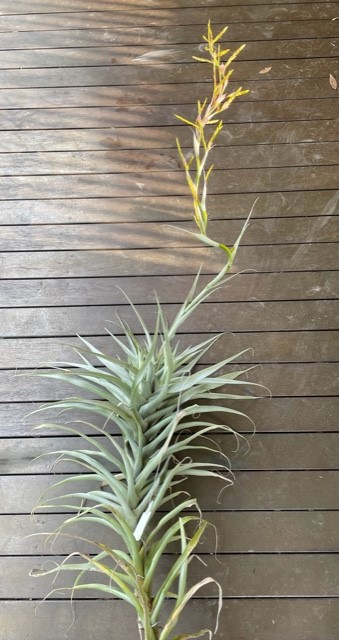

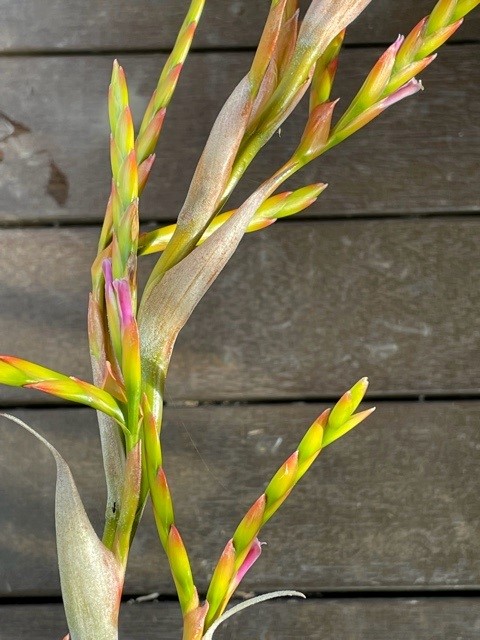

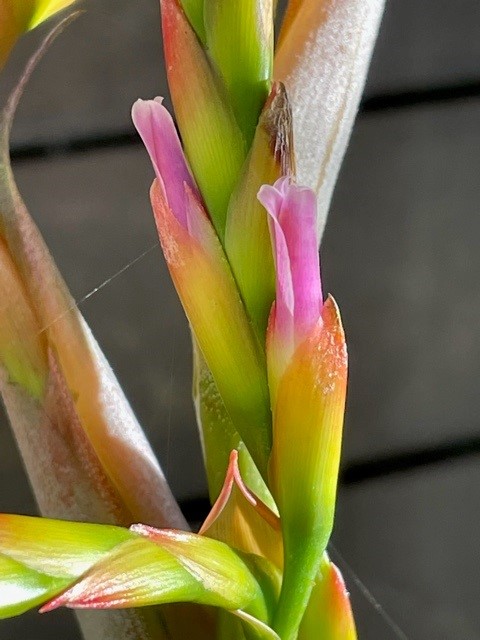

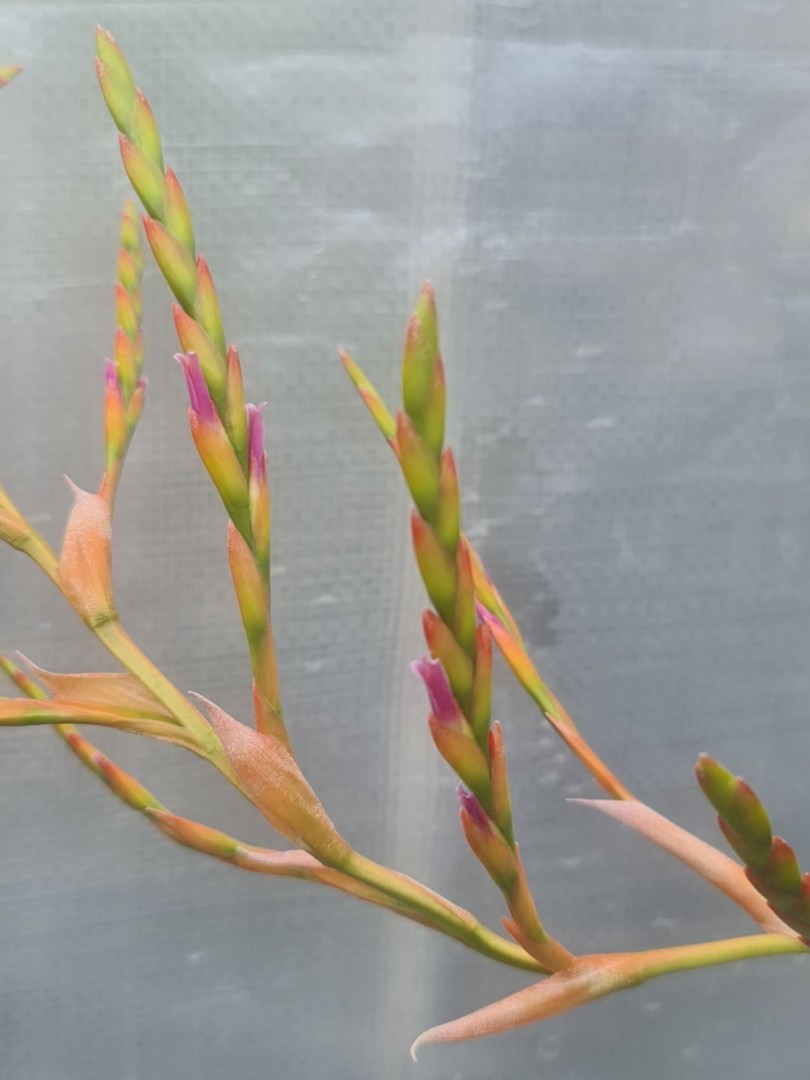
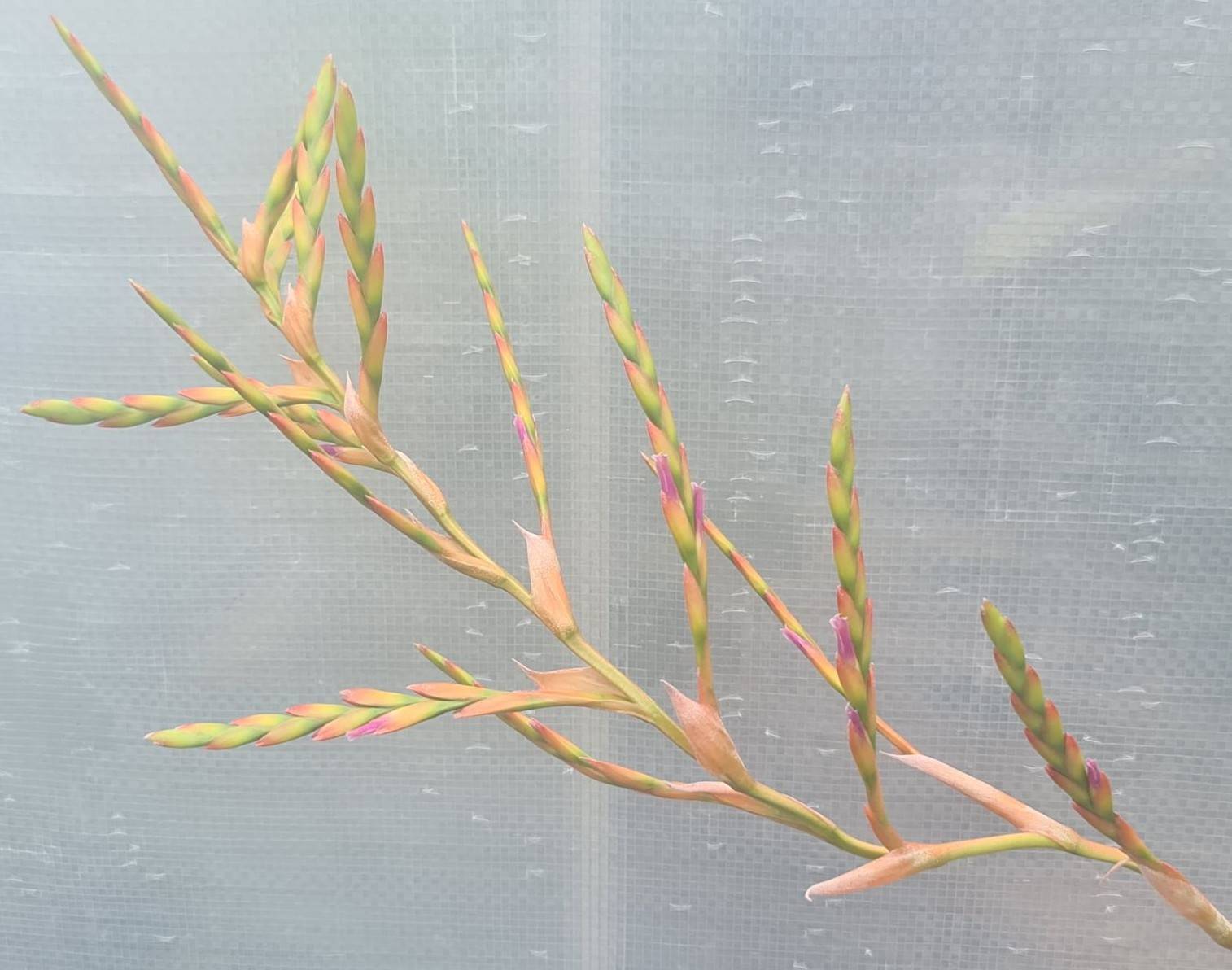
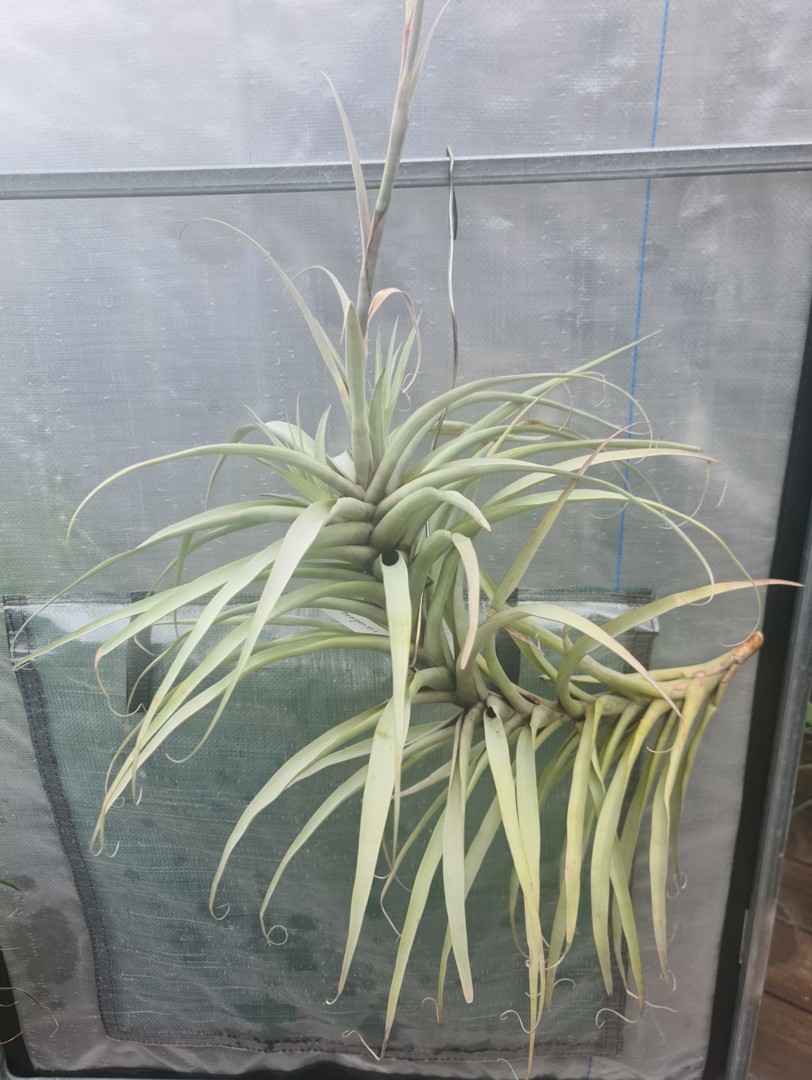
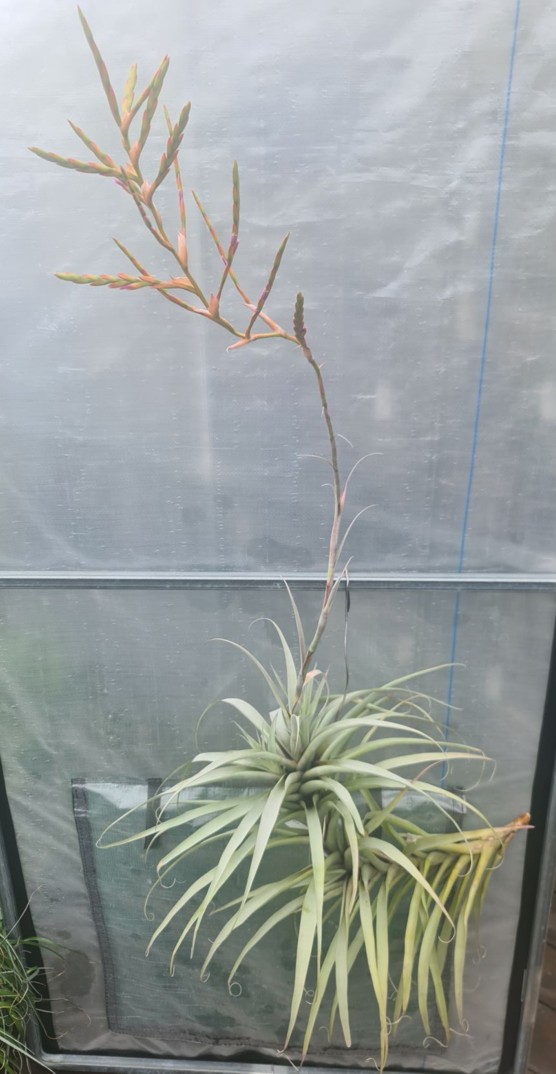
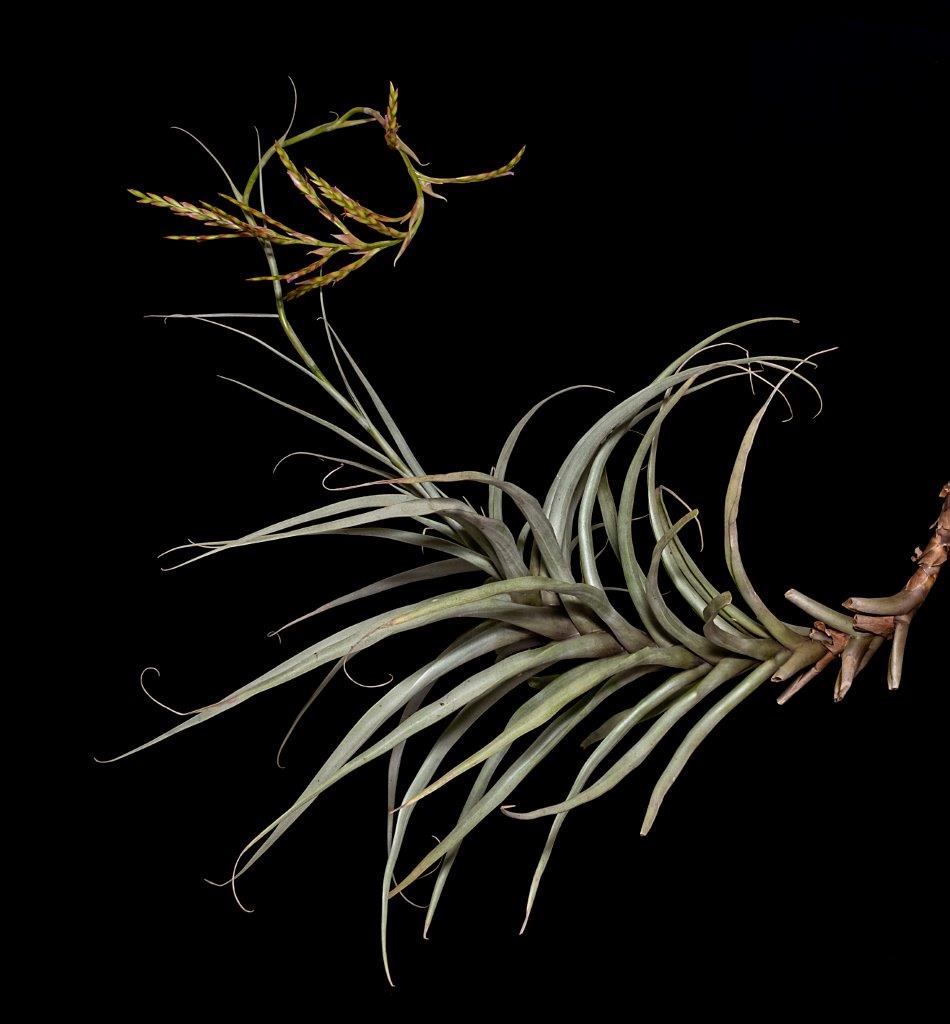
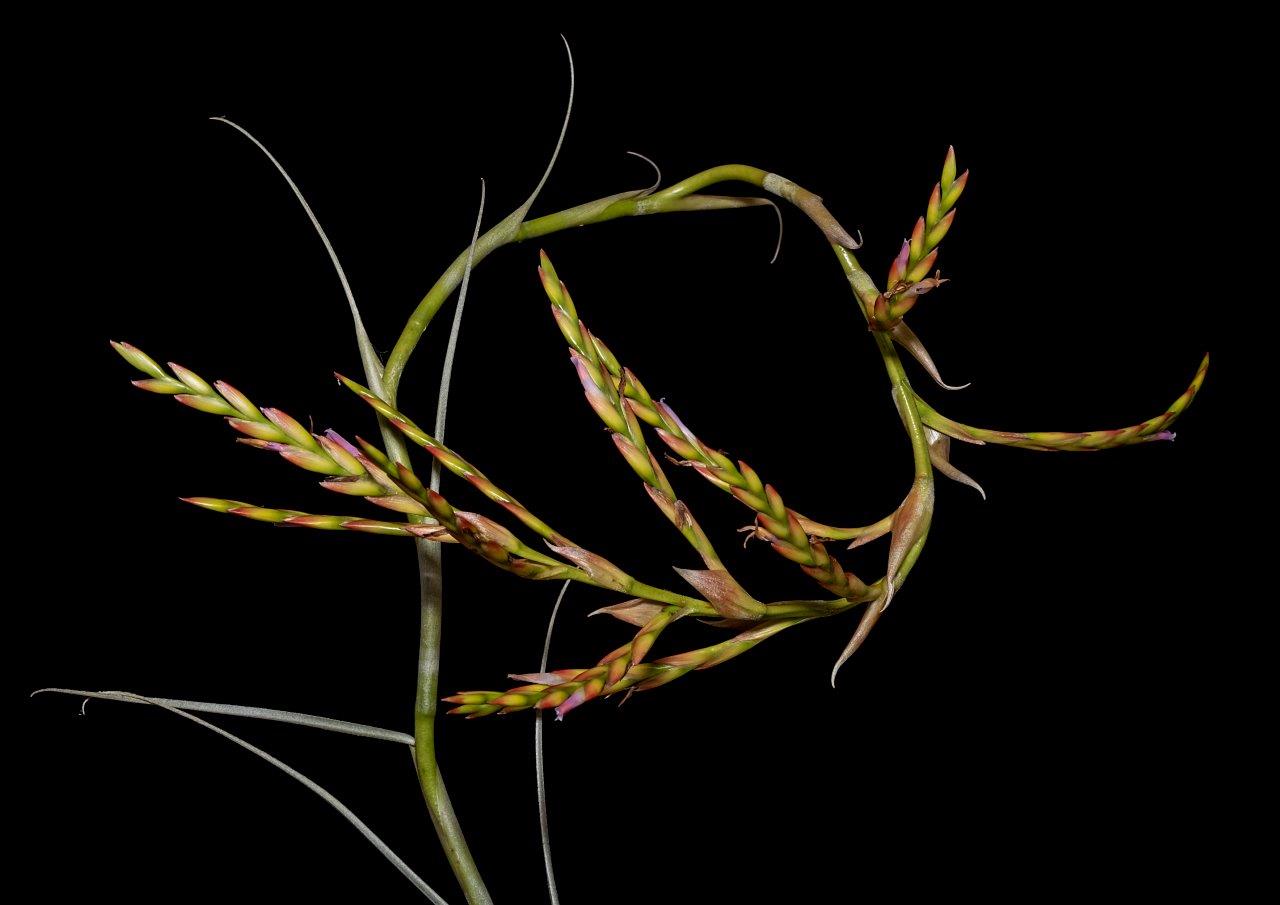

Tillandsia oroyensis var. secundiflora Rauh Trop. Subtrop. Pflanzenwelt 21 : 19-21 1977
Differs from type
Plant larger (flowering to 1.5m high)
Stolons to 50cm long.
Inflorescence tripinnate to 80cm long, ca. 10cm diam.
Flowers at anthesis always hanging down ( secund)
Habitat Steep rocks above Chavin, 3400m, Dept Ancash, Peru
Tillandsia oroyensis Mez, 1919 (Fedde. Repert. Spec. Nov.) p. 77; Mcz, 1935. p. 537; Smith. 1936. p. 562.
Desc from Gilmartin 1972
PLANT 50 cm to 1m tall, erect rosette;
LEAVES 25-55 cm long,
BLADE ca. 2.5 cm wide, narrowly triangular, densely gray-white, moderately appressed lepidote, apex caudate;
SHEATH 9.0-12.0 cm long by 5.0-6.0 cm wide, elliptic;
SCAPE 4-5 mm in diameter, scarcely exceeding leaf-rosette, erect;
SCAPE BRACTS 4.0-20.0 cm long by 1.5-2.0 cm wide, erect with reflexed narrow apices, imbricate throughout;
INFLORESCENCE 20-50 cm long by 4.5-5.5 cm in diameter, erect, red, bipinnate, moderately densely to slightly lepidote, having ca. 17 spikes, ellipsoid to cylindric;
PRIMARY BRACTS mostly to 2.5 cm long, erect-spreading, apex acute to caudate, red, lepidote;
SPIKES 3.0-5.0cm long by 1.5-2.0 cm wide, erect, distance between spikes 1.5- 3.O cm. having 8 to 12 flowers, stipe minimal to 5 mm long, no basal sterile bracts:
FLORAL BRACTS 1.0-1.2 cm long by ca. 7 mm wide, ovate, apex sharply acute, unicarinate, papery, obviously nerved, moderately lepidote without, densely brown-lepidote within, scarcely imbricate, erect-spreading. red;
SEPALS 1.0-1.2 cm long by ca. 5 mm wide, ovate-elliptic, acute, posteriorly connate to 5 mm or equally subfree, red tipped, posteriorly carinate, strongly nerved, glabrous without and within;
PETALS to 1.5 cm long;
OVARY 8-9 mm long by 2-3mm in diameter, stamens included in corolla by ca. 3mm, not plicate or slightly so; stigma barely exserted, distance between flowers 4-5 mm.
MATERIAL EXAMINED: Weberbauer 2523 (B, TYPE; US, photo) Peru; Asplund 17712 (US) Hacienda Pizhin, Prov. Azuay, ca. 2800 m, 23 Nov. 1955.
Tillandsia oroyensis Mez by W Rauh in Trop Subtrop Pflanz. 21: 16-21. 1977
wurde von C. MEZ (Fedde, Rep. XVI, S. 77, 1919) nach Material beschrieben, das von A. Weberbauer zwischen La Oroya und Tarma gesammelt worden war (Sammelnummer 2523, Abb. 8, links). Sie bildet hier in 3400 m Hohe, in Gesellschaft der kleinen T. nana Baker Massenbestande an steilen Kalkfelswanden. Inzwischen wurde T. oroyensis an weiteren Standorten gefunden, so im Tal des Rio Santa bei Huaraz, Dptm. Ancash (Rauh 38730) und von Asplund (17712) bei der Hacienda Pizhin, Prov. Azuay in Ecuador (2800 m, Abb. 8, rechts). Dabei hat sich ergeben, dass T. oroyensis hinsichtlich Grosse, Anzahl und Lange der Ahren recht variabel sein kann. Nach der Originaldiagnose wird die Pflanze bluhend mit 50-100cm Grosse angegeben und besitzt eine aufrechte, aus zahlreichen, schmal-dreieckigen, silbergrau lepidoten, in eine lange, fadige Spitze auslaufenden Blattern gebildete Rosette (Abb. 7, links); der aufrechte Infloreszenzschaft soll die Rosette kaum oder nur wenig uberragen. Infloreszenz 20-50 cm lang, bis 5.5 cm diam, bipinnat, mit 8- bis 12-blutigen, 3-5 cm langen, bis 2 cm breiten, aufrecht-abstehenden, gestielten Ahren (Abb. 7-8). Florale Brakteen scharf zugespitzt, carinat, unterseits schwach, oberseits dicht lepidot, rot, etwa so lang wie die carinaten, kahlen, stark genervten Sepalen. Petalen bis 1,5 cm lang, blau-violett. Staubblatter Griffel tief eingeschlossen.
Trotz aller Variabilitat ist die Anordnung der Bluten stets streng distich (Abb. 7-8).
Auf unserer im Jahre 1976 unternommenen Reise nach Peru konnten wir nun auf einer Fahrt von Catac im Santa-Tal nach Chavin (Dptm. Ancash) auf trockenen Felshangen des tief eingeschnittenen Flugtales in Gesellschaft von Puya mirabilis, Matucana aff. comacephala und niedrigem Montegebiisch auf der at1antischen Andenseite bei 3400 m eine Tillandsia sammeln, die wir zunachst auf grund ihrer tri - bis quadripinnaten Infloreszenzen und ihrer stark abwarts gerichteten Bluten (Abb. 9) fur eine neue Art hielten. Die Bestimmung nach dem Tillandsienschlussel von L. B. SMITH fuhrte jedoch eindeutig zu T. oroyensis MEZ, so dag wir, trotz der bemerkenswerten Abweichungen vom Typus, unsere Pflanze nur als Varietat betrachten konnen. L. B. SMITH, dem wir das Material zur Uberprufung ubersandten, stimmt unserer Auffassung zu.
Von T. oroyensis sind also die beiden Varietaten: var. oroyensis (Diagnose s. S. 17) und die var. secundiflora Rauh zu unterscheiden. Nachfolgend die ausfuhrliche Diagnose der in Abb. 9 wiedergegebenen neuen Varietat.
A typo differt magnitudine (florens usque ad 1.5 m alta), stolonibus usque ad 50 cm longis, inflorescentiis tripinnatis usque ad 80 cm longis, plus minusve 10 cm diametientibus et floribus sub anthesi semper pendulis.
Habitat: In rupibus declivis supra Chavin, 3400 m.s.m. Dptm. Ancash.
Holotypus : Nr. Coll. Rauh 40 402 (27. 7. 1976) in (HEID).
Pf1anze mit dicken, bis 1 m langen, rhizomartigen Auslaufern, bluhend bis 1.5 m hoch. Blatter zahlreich, eine aufrechte, 50-60 cm hohe und bis 70 cm im diam. grosse Rosette bildend (Abb. 9, links). Scheiden lang-elliptisch, 10-12 cm lang, 6-7 cm breit, beiderseits schwarz-braun lepidot. Spreiten schmal-dreieckig, lang-fadig zugespitzt, bis 40 cm lang, oberhalb der Scheide bis 5 cm breit, beiderseits dicht angedruckt silberweiss lepidot; Schuppen mit braunem Zentrum. Infloreszenzschaft aufrecht, bis 80 cm lang, die Rosette welt uberragend, ca. 1 cm dick, rund, kahl, rotlich-braun. Hoch-b1atter dicht imbrikat, die basalen subfoliat mit herabgeschlagener Spreite, die oberen mit langer, karminroter Scheide und kurzer, grau-lepidoter Spreite, langer als die Internodien. Inf1oreszenz 50-80 cm lang, bis 10 cm breit, an der Basis locker quadri-, gegen die Spitze zu dicht tripinnat , mit runder, kahler, rotlicher Achse. Primarbrakteen (ohne Spreiten) kurzer als die Seitenaste 1. Ordnung, mit ovaler bis langlicher, blas-karminroter Scheide, die basalen mit 8-9 cm langer, fadiger Spreite, die oberen nur kurz bespitzt. Sekundar- und Tertiarbrakteen den f loralen Brakteen ahnlich, aber kurzer, kahl, karminrot. Seitenaste 1. Ordnung schrag aufsteigend (Abb. 9, Mitte u. rechts), mit sehr kurzer, steriler Basis, einschlieBlich der Endahre bis 6 cm lang, mit 2-4 Seitenasten 2. oder 3. Ordnung (= Ahren). Ahren locker 3- bis 9-blutig mit seitlich abgeflachter, flexuoser, karminroter, kahler Achse. Bluten locker 2-zeilig, z. Z. der Anthese aber einseits wendig abwarts gerichtet, sich gegenseitig nicht beruhrend, kurz gestielt, bis 1.7 cm lang. Florale Brakteen ecarinat oder gegen die Spitze zu carinat, kurzer als die Sepalen, rundlich-oval, kurz bespitzt, bis 1 cm lang, ausgebreitet bis 1 cm breit, oberseits zerstreut braun-lepidot, unterseits fast kahl, rotlich-violett, glatt (getrocknet stark genervt). Sepalen bis 1.5 cm lang, ausgebreitet an der Basis bis 0.6 cm breit, kurz bespitzt, die beiden hinteren scharf carinat, bis zum Grunde frei, glatt (trocken genervt), an der Spitze rotlich, gegen die Basis zu grun. Petalen schmal-zungenformig, an den stumpfen Spitzen zuruckgebogen, die Sepalen um ca. 5 mm uberragend, blass-rotlichviolett. Staubblatter und Griffel eingeschlossen.
Mit ihren kurzen Ahren und hangenden Bluten zeigt T. oroyensis var. secundiflora eine gewisse habituelle Ahnlichkeit zu T. roetingii (s. S. 12). Verwandtschaftliche Beziehungen zwischen beiden Arten bestehen aber nicht.
Translated by Butcher
Tillandsia oroyensis Mez by W Rauh in Trop Subtrop Pflanz. 21: 16-21. 1977
Described by C. Mez, Fedde, Rep. XVI, S., 77, 1919, from material collected by A Weberbauer between La Oroya and Tarma (under collection number 2523, fig., 8, left).
It grows here up to 3400 m high, in association with small T. nana Baker in continuous masses on steep limestone rocks. Meanwhile T. oroyensis was also found in a wide area in the valley of Rio Santa near Huaraz, Dptm. Ancash, (Rauh 38730), and by Asplund (17712) near the Hacienda Pizhin, Prov. Azuay in Ecuador (2800 m fig. 8, right). With it has emerged that T. oroyensis can be quite variable in size, number and length of spikes. The original diagnosis, indicates the plant flowering to 50-100cm high and with an erect rosette, from numerous, narrow-triangular leaves, silver-grey lepidote, tapering into a long, filiform tip (fig. 7, left); the erect scape hardly or only a little exceeding the rosette. Inflorescense 20-50 cm long, to 5.5 cm in diameter, bipinnate, with 8 to 12 flowers, 3-5 cm long, to 2 cm wide, erect spreading, stemmed spikes (fig. 7-8).
Floral Bracts sharply acuminate, carinate, underneath weak, upperside densely lepidote, red, somewhat as long as the carinate, glabrous, strongly nerved sepals.
Petals to 1.5 cm long, blue-violet. Stamens and Style deeply enclosed.
Despite all the variability, the arrangement of the flowers is always strictly distichous (fig. 7-8).
On our trip to Peru undertaken in the year 1976, we were on a trip to Catac in the Santa valley after Chavin (Dptm. Ancash), on dry steep rocks in the deeply incised river valley in association with Puya mirabilis, Matucana aff. comacephala and low Montane bushes on the atlantic side of the Andes near 3400 m we collected a Tillandsia that we believed to be a new species on the basis of its tri - to quadripinnate inflorescense and its strongly bent downwards flowers (fig. 9). Referring to the Tillandsia key of L. B. SMITH we came to T. oroyensis Mez, and despite the remarkable deviations from Type, could only consider our plant as a variety. L. B. Smith, to whom we had sent material to check, agreed with our opinion.
For T. oroyensis there are therefore two varieties: var. oroyensis, (diagnosis see page 17), and the var. secundiflora Rauh as below. Subsequently the listed diagnosis of that in fig. 9 is shown as a new variety.
A typo differt magnitudine (florens usque ad 1.5 m alta), stolonibus usque ad 50 cm longis, inflorescentiis tripinnatis usque ad 80 cm longis, plus minusve 10 cm diametientibus et floribus sub anthesi semper pendulis.
Habitat: In rupibus declivis supra Chavin, 3400 m.s.m. Dptm. Ancash.
Holotypus : Nr. Coll. Rauh 40 402 (27. 7. 1976) in (HEID).
T. oroyensis var. secundiflora Rauh
Plant with thick, to 1 m long, tapered rhizome-like, flowering to 1.5 m high.
Leaves numerous, forming an erect, 50-60 cm high and to 70 cm in diameter large rosette (fig. 9, left). Sheaths long-elliptic, 10-12 cm long, 6-7 cm wide, both sides black-brown lepidote.
Blades narrow-triangular, long-filiform acuminate, to 40 cm long, above the sheath to 5 cm wide, both sides with dense appressed silver-white lepidote;
scales with brown centre.
Scape erect, to 80 cm long, widely exceeding the rosette, about 1 cm thick, round, glabrous, reddish-brown.
Scape bracts densely imbricate, the basal ones subfoliate with bent over blade, the upper ones with long, crimson sheath and short, grey lepidote blade, longer than the internodes.
Inflorescense 50-80 cm long, to 10 cm wide, at the base lax quadri -, towards the top to dense tripinnate, with round, glabrous, reddish axis.
Primary bracts (without blade) shorter than the primary side-branch, with oval to longish, pale crimson sheath, the basal ones with 8-9 cm long, filiform blade, the upper ones only short tipped.
Secondary and tertiary bracts similar to the floral bracts, but shorter, glabrous, crimson.
Primary side branch slanting ascending, (fig. 9, middle and right), with very short, sterile base, including the end spike to 6 cm long, with 2-4 side spikes of the second and third order (= Spike).
Spikes lax 3 to 9 flowered with sides flattened, flexuous, crimson, glabrous axis.
Flowers laxly in two rows, however at anthesis they are directed secund downwards, towards the side not touching, short stemmed, to 1.7 cm long.
Floral bracts ecarinate or carinate towards the top, shorter than the sepals, roundish-oval, short tipped, to 1 cm long, at its widest to 1 cm wide, upper side scattered brown lepidote, underneath almost glabrous, reddish violet, smooth, (when dried strongly nerved).
Sepals to 1.5 cm long, wider at the base to 0.6 cm wide, short tipped, the posterior pair sharply carinate, free to the base, smooth, (nerved when dry), at the tip reddish, towards the base green.
Petals thin tongue shaped, the blunt tips bent over, exceeding the sepals by about 5 mm, pale reddish violet.
Stamens and Style enclosed.
With its short spikes and hanging flowers T. oroyensis var. secundiflora shows a certain similar habit to T. roetingii (See page 12). However, no direct relationship exists between the two species.